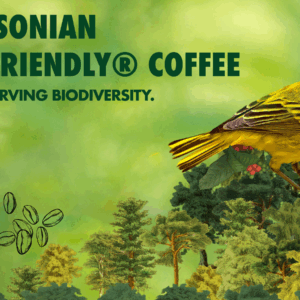The Journey of an Orphaned Cedar Waxwing
Thanks to our Nature Network partner, Salthaven West Wildlife Rehabilitation and Education Centre, for sharing this month’s blog.
This is a bird often heard before it’s seen, though not for its melodic song. On the contrary, this is a songbird without a song! Instead, you’ll likely notice their thin, high-pitched whistles drifting from the branches of fruit trees and bushes. Once you spot one, it’s hard to miss the others—they travel in lively flocks, moving from tree to tree. As one of the few North American birds that specializes in eating fruit, Cedar Waxwings (mâsikêsko-piyêsîs in Plains Cree, Bombycilla cedrorum in Latin) can even survive on fruit alone for several months!
Before I dive deeper into their fascinating behaviors, let me introduce you to one particularly special Cedar Waxwing that spent several weeks in the care of Salthaven West Wildlife Rehabilitation and Education Centre in Regina, Saskatchewan.
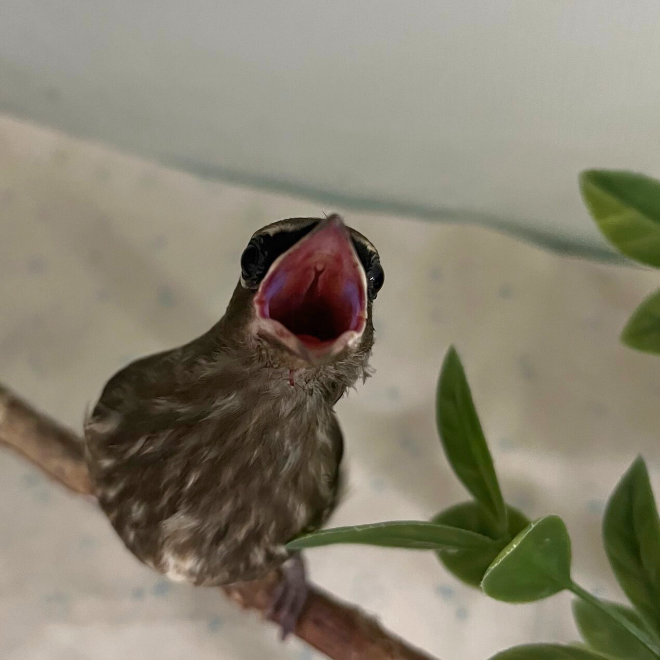
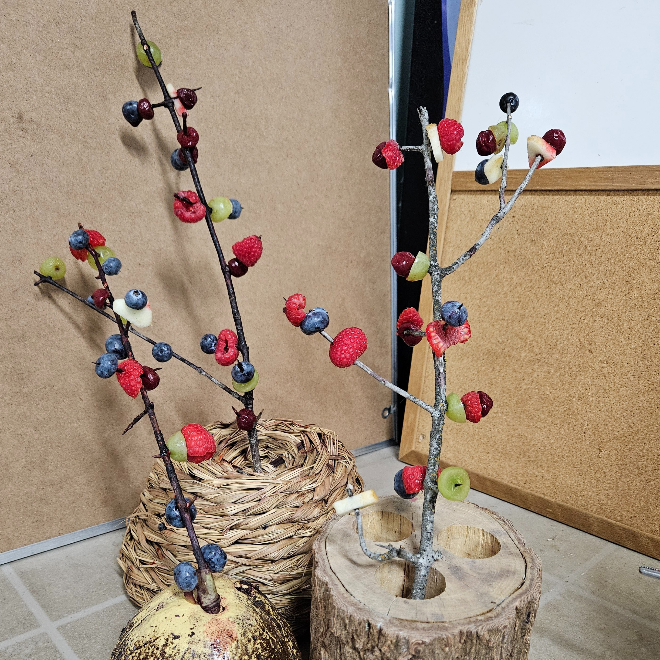
(Left) Our orphaned Cedar Waxwing. (Right) Thorny bushes with food hung for the bird.
One Bird’s Special Journey
This Cedar Waxwing was found as an orphaned nestling and brought to Salthaven West for specialized care. Licensed Wildlife Rehabilitation Centres follow strict protocols when nurturing sick, injured, orphaned, or displaced wildlife to ensure their safety and wellbeing.
Our volunteers were immediately greeted and captivated by the nestling’s striking iridescent purple markings at the corners of its mouth. These vibrant stripes are thought to help parents locate their chicks’ mouths more easily, though the exact function of these markings remains a topic of debate. By means of a bird finger puppet to minimize human imprinting, this nestling was hand-fed a diet of berries paired with protein-rich insects to mirror its natural diet.
As the waxwing fledged its nest, it was time to encourage independent eating. We used thorny bushes to hang fruit vertically, mimicking how waxwings would pluck fruit from branches in the wild. Once it began eating on its own, the bird was transferred to a spacious outdoor enclosure to practice flight.
As the days passed, we watched it develop the signature features of a Cedar Waxwing — a sleek black mask across the eyes and the vibrant yellow band at the base of its tail. Perhaps most exciting was the emergence of the brilliant red “wax droplets” on its wing feathers. These tiny red tips, which grow more prominent with age, are the source of their name. While the exact purpose of these waxy tips remains unknown, they may play a role in attracting mates. There is still so much to learn about this fascinating species!
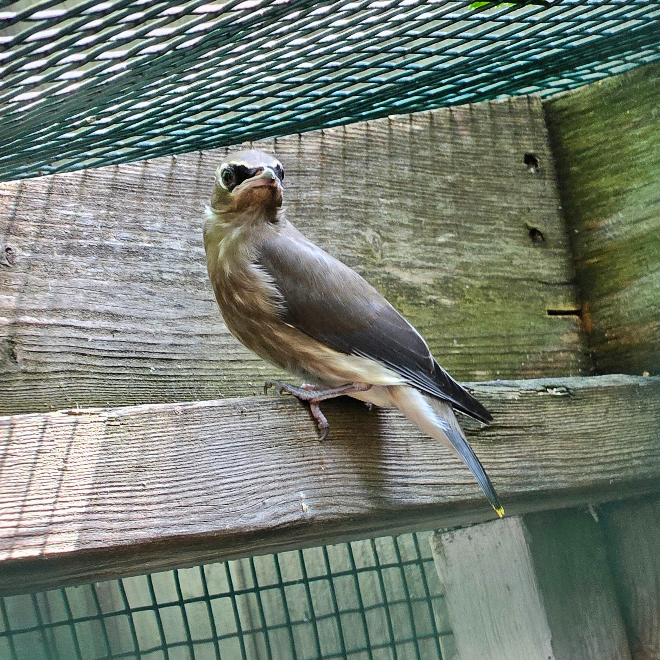
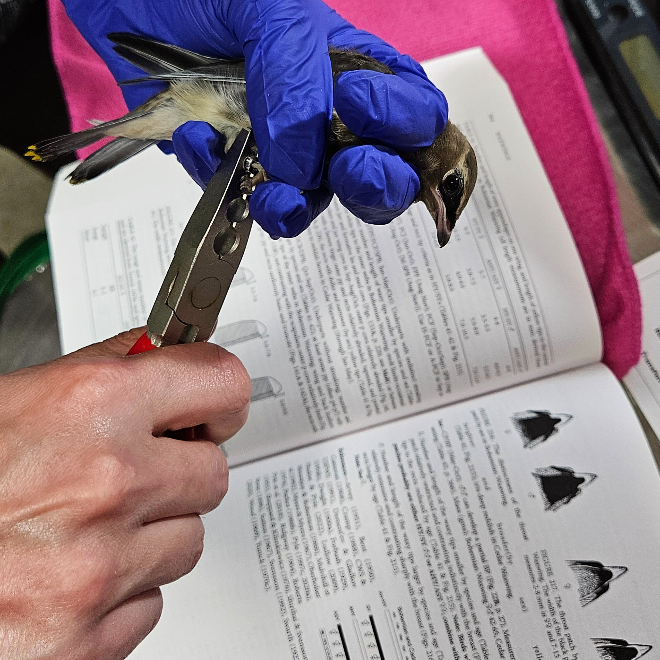
(Left) The waxwing is ready to be released. (Right) Banding the bird before release.
Salthaven West’s Bird Banding Program
Once a songbird patient passes its final wellness check and is ready to be released back into the wild, there is one more important step. Our Bird Banding Program involves placing a small, non-invasive aluminum band with a unique 9-digit number around the bird’s leg. During this process we collect valuable data such as weight, wing chord length (a measurement taken from the wrist to the longest primary feather), fat content, as well as molt and breeding characteristics to help determine the bird’s age and sex. This information is submitted to the North American Bird Banding Program and contributes to a larger body of scientific knowledge.
Bird banding provides vital data for scientific knowledge about birds and the environments in which they live. It provides insights into the number and species of songbirds, ecosystem health, bird longevity, and migration patterns. Additionally, banding allows us to evaluate the effectiveness of our rehabilitation practices, helping refine future care strategies. Given the serious decline in many songbird populations, this data is vital for guiding conservation efforts and preserving biodiversity. If you recover a banded bird, you can report your observations to the Bird Banding Office and you will receive a certificate of appreciation with all the bird’s details.
Released Back into the World
It’s the big day – time to release this Cedar Waxwing back out into the world. Several factors are carefully considered when releasing wildlife back into their natural habitat. We ensure the weather conditions are favorable, check eBird data to confirm the presence of others of the same species in the area, and assess whether the original location is still safe for the bird’s return. Releasing wildlife back into the wild is a heartwarming and deeply rewarding experience, representing the culmination of dedicated care and effort.
I Found a Bird in Need of Help!
If you come across a bird that you think might be injured, call your local Wildlife Rehabilitation Centre before intervening. They will ask a variety of questions to understand the full scope of the situation and provide instructions on how to safely contain the animal if it requires care at a facility. Never provide food or water, as incorrect administration or the wrong diet could lead to serious or fatal outcomes. Thank you for being a wildlife hero!
The Future of Birds
Birds play an essential role in maintaining healthy and resilient ecosystems in our communities and our planet. They control pests, serve as nature’s clean-up crew, disperse seeds, pollinate plants, and help shape landscapes. These activities directly impact human health, the economy, food production, and affect millions of other species. But there are three billion fewer birds in North America today than there were 50 years ago. Much of this loss can be attributed to human activities, and we continue to see a rise in injured birds in need of rehabilitation at Salthaven West due countless preventable, human-caused challenges.
Wildlife rehabilitation centers across Canada are dedicated to protecting and restoring bird populations and reversing these alarming trends. Beyond rehabilitation, we take proactive steps to educate communities on the simple actions they can take to reduce the challenges birds face as they live, breed, and migrate through our neighborhoods. For tips on how you can help, check out Nature Canada’s blog on preventing bird collisions: 8 Tips to Help Birds.
Want to help Canadian species like the Cedar Waxwing and more? Stay tuned with the latest in Canadian nature by subscribing for email updates. You’ll receive regular updates about what we’re doing to protect Canadian nature and how you can help.
For more information:
Birds of Saskatchewan. 2019. Alan R. Smith, C. Stuart Houston and J. Frank Roy. Manley Callin Series No. 8. 🔗
Nearly 3 Billion Birds Gone. Cornell Lab of Ornithology. 🔗
Cedar Waxwings, Birds of the World, Cornel Lab of Ornithology. 🔗
What’s Up With the Weird Mouths of These Finch Chicks? Audubon. 🔗

